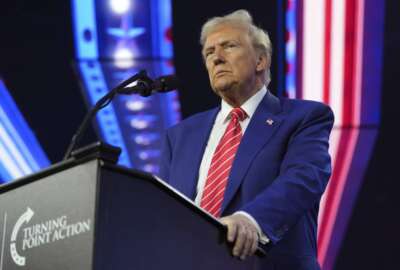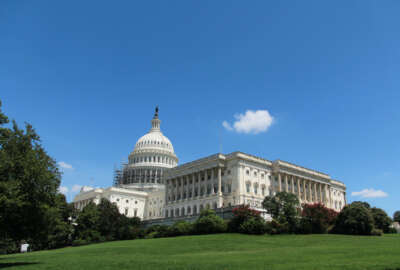Obama earns green thumb for sustainability record
Jon Powers is the Federal Environmental Executive for the White House Council on Environmental Quality. He spoke to Federal News Radio as part of the special...
wfedstaff | April 17, 2015 4:08 pm
 Federal agencies have made noticeable improvements in the adoption of green technologies, but even small steps like double-sided printing or trimming down the number of personal printers federal employees keep on their desks are also adding up.
Federal agencies have made noticeable improvements in the adoption of green technologies, but even small steps like double-sided printing or trimming down the number of personal printers federal employees keep on their desks are also adding up.
The President’s call for the government to be a leader in sustainability has government workers at all levels thinking green.
Federal News Radio believes the administration has effectively pursued its sustainability policies. Agency culture is changing and the agencies are being graded and reviewed to make sure they are complying with a 2009 executive order calling for the government to lead the way toward a clean energy economy.
The rating is part of Federal News Radio’s special report, The Obama Impact: Evaluating the Last Four Years. Throughout the series, Federal News Radio examines 23 different ideas and initiatives instituted by the Obama Administration and ranks them as effective, ineffective and more progress needed. 
| Why Sustainability was rated effective |
| Reason #1: Agencies made notable progress toward energy sustainability goals.
Reason #2: Agencies appointed Senior Sustainability Officers. Reason #3: GSA’s Green Toolkit helped agencies buy “greener” products and services. (More primary source material available on The Obama Impact Resource Page) |
The OMB scored 15 agencies on their sustainability and use of energy. Of those, 10 received a green score in at least four of the seven categories focusing on greenhouse gas emissions, reducing energy, and increasing the use of renewable energy, reduction of water, reduction in fleet petroleum use and increase in green buildings.
The Environmental Protection Agency and the General Services Administration each earned seven greens scores. NASA and the Labor Department earned six greens while the National Archives and Records Administration, the departments of Veterans Affairs, Treasury, Interior, Health and Human Services, Commerce, Agriculture, the Smithsonian Institution and the Tennessee Valley Authority all garnered five of the highest scores.
Only the departments of Defense, Homeland Security, Housing and Urban Development, Transportation, and the Office of Personnel Management received three or fewer green scores. The Army Corps of Engineers received seven red scores and the scorecard for the Small Business Administration is not available.
Agency culture is also changing as a result of the “green” commitment. OMB says 61 agencies have appointed a senior sustainability officer, including all 15 cabinet agencies, and GSA’s green toolkit helps agencies buy more sustainable products and services.
And the results are real.
Text continues after video
Agencies are reducing the expense of cooling buildings in the summer by replacing an old roof with a white roof that reflects light and heat. Other agencies have installed green roofs, which are covered in plants to reduce storm water run-off and also keep the building cooler.
And in West Virginia, a VA medical center reduced its food costs by buying 30 percent of its fresh produce from local farmers. The center also donates leftover food to a local veterans housing center and composts inedible food, which can eventually be used to landscape the grounds.
“In one year alone, it saved the medical center $67,000 just because of smarter purchasing habits. So it’s not just about going green but it’s about being more efficient both fiscally and environmentally as well,” said Jon Powers, the Federal Environmental Executive of the White House’s Council on Environmental Quality.
|
Obama appointed Powers in April. He is responsible for promoting environmental and energy sustainability across federal government operations.
Powers spoke to The Federal Drive with Tom Temin and Emily Kopp Monday morning to talk about how well federal agencies have brought sustainable practices into the government.
“We’ve seen tremendous progress. We’ve seen reduced greenhouse gases. We’ve seen reduced water use. We’ve seen increased efforts around renewable energy. There’s an understanding now, both because of the enthusiasm of many of the federal workers that are involved in this and some of the innovation and creativity they pushed towards their solutions, that this is both about making a great environmental impact but also about saving money,” Powers said.
Technology and incorporating green building design standards into the 500,000 buildings and facilities the federal government operates helps accomplish many of the administration’s green goals. But Powell says bringing federal workers on board is just as important. And it’s taken leadership at each of the agencies, from the Oval Office down, to encourage 1.8 million civilian employees to make this happen, Powers said.
And it started with the president’s executive order, which requires federal agencies to reduce greenhouse gas pollution, eliminate waste, improve energy and water performance, and to leverage Federal purchasing power to support innovation and entrepreneurship in clean energy technologies and environmentally-responsible products.
“There’s no doubt about it, the president’s call for leadership on this has been critical, not just a call for leadership, but actually holding agencies accountable for what they are doing,” Powers said.
In his role, Powers calls senior-level agency officials each month to get a report on their progress. The agencies must also develop sustainability plans — similar to those used by major corporations like Coca-Cola and Wal-Mart — that spell out how agencies will meet specific goals, like reducing their reliance on petroleum products.
That can mean reviewing whether the agency has the right number of cars in its fleet or how to better use solar panels. The council has also organized symposiums, including one scheduled for next week, to bring together senior policy-makers and experts to share ideas and learn from one another.
“We’re connecting the dots on some of these best lessons learned,” Powers said.
Part 1: Evaluating the Obama administration’s management initiatives
Part 2: Evaluating Obama’s technology reforms
Part 3: Evaluating Obama’s workforce initiatives
Part 4: Evaluating Obama’s acquisition efforts
Part 5A: What would a second-term for President Obama mean for feds?
Part 5B: What would a Romney presidency mean for federal workers?
Copyright © 2024 Federal News Network. All rights reserved. This website is not intended for users located within the European Economic Area.





